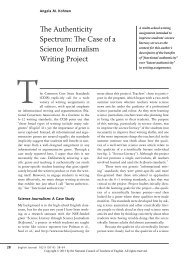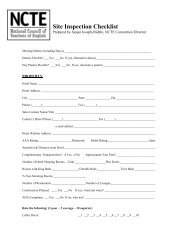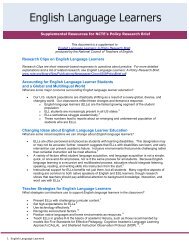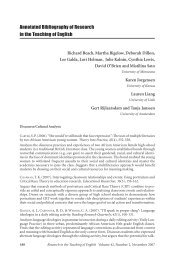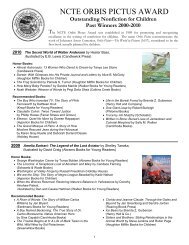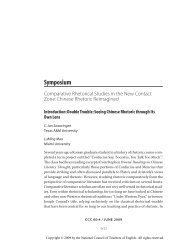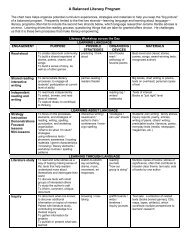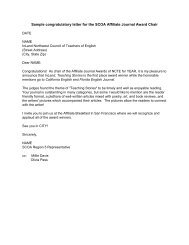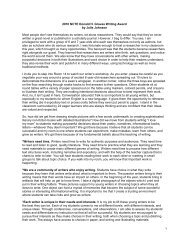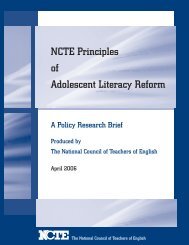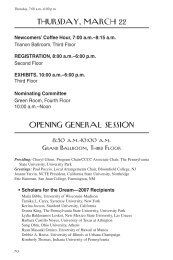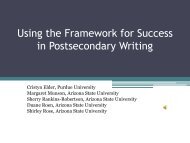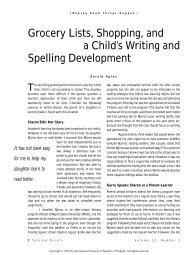Annotated Bibliography of Research in the Teaching of English
Annotated Bibliography of Research in the Teaching of English
Annotated Bibliography of Research in the Teaching of English
- No tags were found...
You also want an ePaper? Increase the reach of your titles
YUMPU automatically turns print PDFs into web optimized ePapers that Google loves.
<strong>Annotated</strong> <strong>Bibliography</strong> 213READY, D. D., LOGERFO, L. F., BURKAM, D. T., & LEE, V. E. (2005). Expla<strong>in</strong><strong>in</strong>g girls’ advantage <strong>in</strong>k<strong>in</strong>dergarten literacy learn<strong>in</strong>g: Do classroom behaviors make a difference? The Elementary SchoolJournal, 106(1), 21-38.Explores gender differences <strong>in</strong> literacy learn<strong>in</strong>g us<strong>in</strong>g data from 16,883 k<strong>in</strong>dergarteners <strong>in</strong> <strong>the</strong>Early Childhood Longitud<strong>in</strong>al Study to discover which student behaviors contribute most to<strong>the</strong> differential learn<strong>in</strong>g results for boys and girls. Data <strong>in</strong>clude demographic <strong>in</strong>formation, literacyperformance <strong>in</strong> <strong>the</strong> fall and spr<strong>in</strong>g, and behavior rat<strong>in</strong>gs <strong>in</strong> five categories from children’steachers. F<strong>in</strong>ds that, on average, girls enter school with better-developed literacy skills that help<strong>the</strong>m learn more dur<strong>in</strong>g <strong>the</strong> school year. This is <strong>the</strong> major variable account<strong>in</strong>g for <strong>the</strong> gendergap. The rema<strong>in</strong><strong>in</strong>g portion <strong>of</strong> <strong>the</strong> gap was best accounted for by <strong>the</strong> group <strong>of</strong> behaviors labeled“approaches to learn<strong>in</strong>g,” <strong>in</strong>clud<strong>in</strong>g attentiveness and task persistence. The category <strong>of</strong> “externaliz<strong>in</strong>gproblem behaviors,” more common <strong>in</strong> boys, did little to account for <strong>the</strong> gender gap <strong>in</strong>literacy learn<strong>in</strong>g.SOLOMON, S., & VAN ROOYEN, L. (2005). Illiterates <strong>in</strong> South Africa: Who are <strong>the</strong>y and what motivates<strong>the</strong>m to participate <strong>in</strong> literacy campaigns? International Review <strong>of</strong> Education, 51(5/6), 479-497.Explores key factors <strong>in</strong>fluenc<strong>in</strong>g <strong>the</strong> participation <strong>of</strong> adult learners <strong>in</strong> literacy campaigns <strong>in</strong>South Africa. The study underscores that illiterates are <strong>of</strong>ten motivated by <strong>the</strong> same desire forself-actualization as any o<strong>the</strong>r member <strong>of</strong> society, and may stop participat<strong>in</strong>g <strong>in</strong> classes unlesseducators are more responsive to <strong>the</strong>ir needs and aspirations. Vocational and economic expectations,children’s education, family relations, health, social motives, and gender issues, as wellas simply <strong>the</strong> hope for a better future, all need to be taken <strong>in</strong>to account. It is also shown thatfunctional literacy <strong>in</strong> itself does not automatically empower women <strong>in</strong> <strong>the</strong> workplace.TAYLOR, M. C. (2006). Informal adult learn<strong>in</strong>g and everyday literacy practices. Journal <strong>of</strong> Adolescentand Adult Literacy, 49(6), 500-509.Explores <strong>the</strong> <strong>in</strong>formal learn<strong>in</strong>g activities that adults with low literacy skills engage <strong>in</strong> and how<strong>the</strong>se activities relate to <strong>the</strong>ir literacy practices. The <strong>in</strong>formants <strong>in</strong>cluded six males and fourfemale adults, and all had less than n<strong>in</strong>e years <strong>of</strong> formal education. Data collection occurredover a three-month period for each adult us<strong>in</strong>g four data collection tools: an orally adm<strong>in</strong>istered<strong>in</strong>formal learn<strong>in</strong>g survey; observations at home, <strong>in</strong> <strong>the</strong> community, or at work;semistructured <strong>in</strong>terviews; and <strong>the</strong> collection <strong>of</strong> artifacts. The study describes a range <strong>of</strong> oraland text-based practices useful for educators and policy development.O<strong>the</strong>r Related <strong>Research</strong>:AARON, J., BAUER, E. B., COMMEYRAS, M., COX, S. D., DANIELL, B., ELRICK, E., ET AL. (2006). No deposit,no return: Enrich<strong>in</strong>g literacy teach<strong>in</strong>g and learn<strong>in</strong>g through critical <strong>in</strong>quiry pedagogy. Newark,DE: International Read<strong>in</strong>g Association.ALIM, H. S. (2006). Roc <strong>the</strong> mic right: The language <strong>of</strong> hip hop culture. New York: Routledge.ALVERMANN, D., HINCHMAN, K. A., MOORE, D. W., PHELPS, S. F., & WAFF, D. R. (EDS.). (2006).Reconceptualiz<strong>in</strong>g <strong>the</strong> literacies <strong>in</strong> adolescents’ lives (2nd ed.). Mahwah, NJ: Erlbaum.ANDERSON, J., KENDRICK, M., ROGERS, T., & SMYTHE, S. (EDS.). (2005). Portraits <strong>of</strong> literacy acrossfamilies, communities, and schools: Intersections and tensions. Mahwah, NJ: Erlbaum.ARAM, D. (2006). Early literacy <strong>in</strong>terventions: The relative roles <strong>of</strong> storybook read<strong>in</strong>g, alphabeticactivities, and <strong>the</strong>ir comb<strong>in</strong>ation. Read<strong>in</strong>g and Writ<strong>in</strong>g, 19(5), 489-515.ASKOV, E. N., KASSAB, C., & WEIRAUCH, D. (2005). Women <strong>in</strong> Pennsylvania’s family literacy programs:Effects <strong>of</strong> participant characteristics on extent <strong>of</strong> participation. Adult Basic Education,15(3), 131-149.AU, K. (2006). Multicultural issues and literacy achievement. Mahwah, NJ: Erlbaum.BARONE, D. M. (2006). Narrow<strong>in</strong>g <strong>the</strong> literacy gap: What works <strong>in</strong> high-poverty schools. New York:Guilford.



